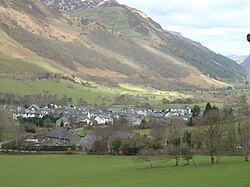Abergynolwyn
| Abergynolwyn | |
| Merionethshire | |
|---|---|
 Abergynolwyn | |
| Location | |
| Grid reference: | SH679070 |
| Location: | 52°38’38"N, 3°57’11"W |
| Data | |
| Post town: | Tywyn |
| Postcode: | LL36 |
| Dialling code: | 01654 |
| Local Government | |
| Council: | Gwynedd |
| Parliamentary constituency: |
Dwyfor Meirionnydd |
Abergynolwyn is a village in Merionethshire, standing at the meeting of the Nant Gwernol with the River Dysynni. The name of the village means 'Mouth of the River with a Whirlpool'. Here is a station of the Talyllyn Railway, now a narrow-gauge heritage railway, but once a working railway bring ing slate form the hills to the coast.
History
Historically, the village's main industry was slate quarrying. The village was founded in the 1860s to house workers at the nearby Bryn Eglwys quarry. The quarry brought in migrant workers from far and wide, and at one time the village had an Anglican church and three nonconformist chapels. The slate was carried to the coast on the Talyllyn Railway.
A decline in the demand for Welsh slate caused reductions in the workforce, and the quarry finally closed in 1948. Today farming, forestry and tourism are the major local industries.
Talyllyn Railway
- Main article: Talyllyn Railway
The village pub, the Railway Inn, is named after the Talyllyn Railway whose narrow gauge branch once reached into the heart of the village down an incline from a ledge on the hillside above. The railway now terminates at Nant Gwernol station above the village, although for many years the terminus was at Abergynolwyn Station outside the village.[1]
Local attractions
Llyn Mwyngil (Tal-y-llyn Lake), just upstream from Abergynolwyn is an unspoilt lake created when a massive landslide blocked the valley long ago.[2] Hiking trails to the summit of Cadair Idris start from here.
The Iron Age fort on Craig yr Aderyn shows that the area was strategically important in prehistoric times. In 1221, Llewellyn the Great built Castell y Bere near Llanfihangel-y-Pennant. It was later besieged by forces under Edward I of England, in 1282.
Outside links
| ("Wikimedia Commons" has material about Abergynolwyn) |
References
- ↑ "Things to Do". Talyllyn Railway. http://www.talyllyn.co.uk/things-to-do.
- ↑ Stephens, Nicholas (1990). Natural Landscapes of Britain from the Air. CUP Archive. pp. 64–65. ISBN 978-0-521-32390-1. https://books.google.com/books?id=0yE9AAAAIAAJ&pg=PA64.
